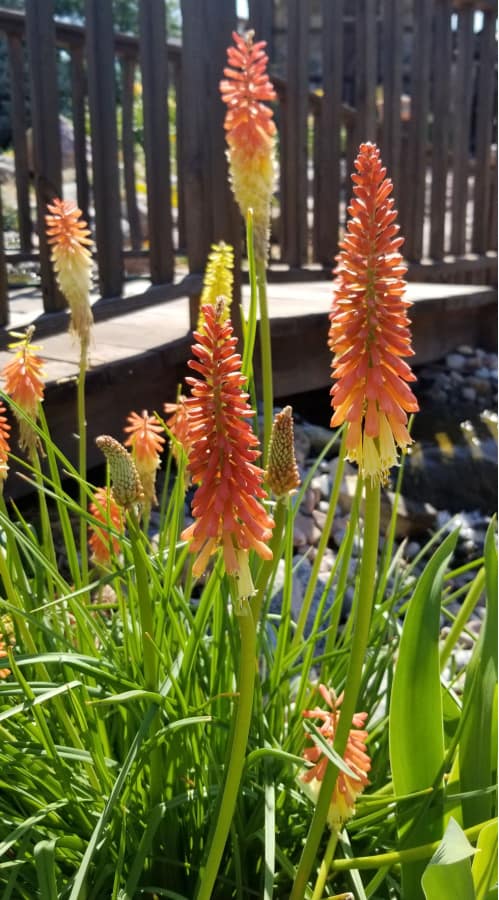Nepeta, also know as catmint, is our June Plant of the Month. Catmint has become one of the most popular perennials over the last 20 years, for many reasons. When I first started as a draftsman in Manhattan, KS, I found that this plant was one of the most used perennials for xeriscaping, or drought-tolerant gardens.
Because of its durability, and attractiveness in the landscape, many new cultivars have emerged. Bees and butterflies love it, and maintenance is minimal, though somewhat annoying. Let me explain all this further.
Reasons to love nepeta in the garden
- It is drought tolerant and tough
- There are many cultivars for every size of landscape
- Bees and butterflies love it
- It is easy to maintain
1. Nepeta is drought tolerant and tough
Like I said above, my first employment in landscaping found me using much nepeta in xeric gardening in Manhattan, KS. Catmints are very tough plants in both heat and drought, though standing water will kill them. This is why I never recommend using irrigation on nepeta. Once it is established, it will grow for many years.
When I discuss maintenance in a bit, you will see just how tough this stuff is. While I would not call it a long lived perennial, it will still grow from 5 to 15 years in a landscape, without division or replanting.
2. There is a cultivar of nepeta for every landscape size
Unfortunately, there is no catmint that does well in shade or wet areas, but we need something to take blazing heat and sun. I often try to discourage homeowners from putting in landscaping with inorganic mulch (rock) and weed barrier, because few plants like the situation. But catmint loves it.
If you have a tiny lot and still want a tough perennial to go against the brick of the house, catmint will thrive. Look at the following cultivars to see which would be best for you.
- ‘Little Trudy’ – 12″ tall by 18″ wide, this is one of the smallest of the catmints
- ‘Walker’s Low’ – 24″ tall by 48″ wide, this is the biggest but most impressive. It was the 2007 Perennial Plant of the Year
- ‘Junior Walker’ – 15″ tall by 30″ wide, supposed to be smaller selection of ‘Walker’s Low’
- ‘Purrsian Blue‘ – 18″ tall by 30″ wide
- ‘Cat’s Pajamas‘ – 14″ tall by 20″ wide
- ‘Cat’s Meow’ – 20″ tall by 36″ wide

3. Bees and Butterflies love nepeta

Working in landscape maintenance, and as an avid amateur entomologist, I have seen what this plant attracts. Mainly, honeybees. If you are looking for something to attract and provide pollen and nectar to honeybees, this plant is it. The flowers are easy for bees to get to and they really work it hard.
Other pollinators besides bees also work the flowers. These can include many butterflies and moths, flies, wasps, and beetles. But mostly, its bees, both native bees and honeybees.
4. Nepeta is easy to maintain
It is true that nepetas are easy to maintain, which is one of the reasons for its selection to Plant of the Month. There are no pests or diseases, and the only time it looks bad is when it gets overwatered from irrigation or rain. I like to cut it back in autumn, hard to the ground after a hard freeze. The stubble that is left is usually about 3 to 6 inches tall.
One thing that has to be done with the large catmints, such as ‘Walker’s Low’, is to cut the plant back by 1/3 to 1/2 in summer, after July 4th. After you do this, the plant will respond with fresh new growth and new flowers. This is what I mean by toughness. It likes being cut back!

Companion plants
Since catmint is such a tough plant, you have to put it in a spot where it will thrive, with low water and heat. That means you will also need to put in companion plants with the same requirements. The following is a list of 10 plants that thrive in the same conditions as catmint.
- Liatris spicata ‘Kobold‘
- Sedum ‘Autumn Fire‘, ‘Thundercloud’ ‘Autumn Joy’
- False sunflower ‘Burning Hearts‘, ‘Tuscan Sun’. ‘Tuscan Gold’
- Red Hot Poker ‘Flashpoint’, ‘Backdraft’, ‘Joker’s Wild‘
- Hibiscus ‘Candy Crush’, ‘Cherry Cheesecake’, ‘Cranberry Crush‘
- Salvia ‘May Night‘, ‘Caradonna‘, ‘Lyrical Blues‘, ‘Lyrical Rose‘
- Rose verbena, Glandularia canadensis
- Blue grama ‘Blonde Ambition‘
- Black Sampson, Echinacea angustifolia
- Woolly Verbena, Verbena stricta
Conclusion
Nepeta is the one to have for the toughest site and toughest conditions. If you live in the central to lower Great Plains or lower side of the Midwest, this is the plant for you, as long as it goes in a hot, sunny, dry spot.
Happy planting!





Thank you for the information on when to cut back for a second bloom and after a hard freeze. We will give that a try.